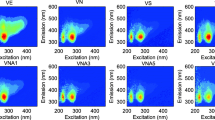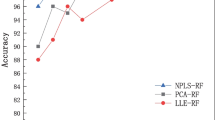Abstract
Dendrobium officinale is a rare and endangered perennial herb in China, which have been used in preparing Chinese tonic medicine for hundreds of years. The severe shortage of this herb and high price have caused that many similar plants were processed as an adulterant and it became difficult to distinguish genuine D. officinale by traditional authentication methods. A sensitive, convenient, and specific method for rapid identification of D. officinale is urgently needed. In the present study, 3D front-face fluorescence technique merged with Independent Component Analysis was used to get the “pure” independent fluorescence signals. The overall 3D-FFF spectra were decomposed into seven independent components (IC). To distinguish D. officinale from other species, IC1 and IC4 were chosen as fluorescence markers and the fluorescence intensity (FI) value at 340 nm/ 442 nm (excitation /emission wavelength) of IC1and 315 nm/ 468 nm of IC4 were used to build a linear model for identifying D. officinale successfully. Compared with other Dendrobium species, D. officinale showed much higher FI1 and FI4 value which is a direct criterion for identification. Meanwhile, even though the FI values of D. officinale may fluctuate due to the difference of growing conditions, the relation between FI1 and FI4 amazingly always fit the linear model constructed (FI4 = 9.9046 + 0.6119FI1, R2 = 0.9811). The linear model is an important finding and specific for D. officinale. Based on the FI value and the goodness of fit in the linear model, D. officinale can be identified quickly.






Similar content being viewed by others
Data Availability
All data generated or analysed during this study are included in this published article and its supplementary information files.
Abbreviations
- 3D-FFF:
-
3D front-face fluorescence spectrometry
- ICA:
-
independent component analysis
- IC:
-
independent components
- JADE:
-
Joint Approximate Diagonalization of Eigen matrices
- FI:
-
fluorescence intensity
References
Xu H, Wang Z, Ding X, Zhou K, Xu L (2006) Differentiation of dendrobium species used as "Huangcao Shihu" by rDNA ITS sequence analysis. Planta Med 72(1):89–92. https://doi.org/10.1055/s-2005-916228
Zhu GH, Tsi ZH, Wood JJ, Wood HP (2009) Flora of China in: Zhu GH, Tsi ZH, Wood JJ, Wood HP (eds) Flora of China vol 25. Science Press, Beijing, pp 367–397
Bao XS, Shun QS, Chen LZ (2001) The color map of medicinal plants of dendrobium (Shi-hu) in China. Fudan University Press, Shanghai
Ding XY, Wang ZT, Xu LS, Xu H, Zhou K, Shi GX (2002) Study on sequence difference and SNP pheomenon of rDNA ITS region in F type and H type population of Dendrobium officinale. China Journal of Chinese Materia Medica 27:85–89
Zhao H, Song F, Liu S, Chen G, Wei C, Liu Y, Liu J (2013) A fluorescence spectroscopy study of traditional Chinese medicine Angelica. Opt Spectrosc 115(4):530–536. https://doi.org/10.1134/S0030400X13100068
Zhang Y, Chen C The fluorescence spectroscopy recognition of the traditional Chinese medicine injection based on the lifting wavelet-BP-Fuzzy Neural Network. In: Intelligent Robot Systems (ACIRS) (2017) 2nd Asia-Pacific conference, 2017. IEEE, pp:93–97
Yang F, Liu C, Wei Y (2012) Fluorimetric analysis of paeonol in Chinese herbal medicine Cynanchi Paniculati radix by aluminum ion-sensitized fluorescence. Acta Pharm Sin B 2(3):294–299. https://doi.org/10.1016/j.apsb.2012.01.008
Chen GZ, Huang XZ, Xu JG, Zheng Z, Wang Z (1990) The methods of fluorescence analysis, vol 112. Science Press, Beijing
Jiang JK, Wu J, Liu XH (2010) Fluorescence properties of lake water. Guang Pu Xue Yu Guang Pu Fen Xi 30(6):1525–1529
Stedmon CA, Bro R (2008) Characterizing dissolved organic matter fluorescence with parallel factor analysis: a tutorial. Limnol Oceanogr Methods 6(11):572–579. https://doi.org/10.4319/lom.2008.6.572
Diez R, Ortiz MC, Sarabia L, Birlouez-Aragon I (2008) Potential of front face fluorescence associated to PLS regression to predict nutritional parameters in heat treated infant formula models. Anal Chim Acta 606(2):151–158. https://doi.org/10.1016/j.aca.2007.11.010
Antunes MCG, Esteves da Silva JCG (2005) Multivariate curve resolution analysis excitation-emission matrices of fluorescence of humic substances. Anal Chim Acta 546(1):52–59. https://doi.org/10.1016/j.aca.2005.05.003
Comon P (1994) Independent component analysis, a new concept? Signal Process 36(3):287–314. https://doi.org/10.1016/0165-1684(94)90029-9
Bahram M, Bro R, Stedmon C, Afkhami A (2006) Handling of Rayleigh and Raman scatter for PARAFAC modeling of fluorescence data using interpolation. J Chemom 20(3–4):99–105. https://doi.org/10.1002/cem.978
Garcia R, Boussard A, Rakotozafy L, Nicolas J, Potus J, Rutledge DN, Cordella CBY (2016) 3D-front-face fluorescence spectroscopy and independent components analysis: a new way to monitor bread dough development. Talanta 147 (supplement C):307-314. doi:https://doi.org/10.1016/j.talanta.2015.10.002
Kassouf A, El Rakwe M, Chebib H, Ducruet V, Rutledge DN, Maalouly J (2014) Independent components analysis coupled with 3D-front-face fluorescence spectroscopy to study the interaction between plastic food packaging and olive oil. Anal Chim Acta 839:14–25. https://doi.org/10.1016/j.aca.2014.06.035
Rutledge DN, Jouan-Rimbaud Bouveresse D (2015) Corrigendum to ‘independent components analysis with the JADE algorithm’. TrAC trends in analytical chemistry 67 (supplement C):220. doi:https://doi.org/10.1016/j.trac.2015.02.001
Rutledge DN, Jouan-Rimbaud Bouveresse D (2013) Independent components analysis with the JADE algorithm. TrAC trends in analytical chemistry 50 (supplement C):22-32. doi:https://doi.org/10.1016/j.trac.2013.03.013
Jouan-Rimbaud Bouveresse D, Moya-González A, Ammari F, Rutledge DN (2012) Two novel methods for the determination of the number of components in independent components analysis models. Chemometrics and intelligent laboratory systems 112 (supplement C):24-32. doi:https://doi.org/10.1016/j.chemolab.2011.12.005
Blind separation of real signals with JADE (2013) http://perso.telecom-paristech.fr/~cardoso/Algo/Jade/jadeR.m
Lakowicz JR (2010) Principles of fluorescence spectroscopy. Protein Fluorescence, Springer Science & Business Media, New York
Food Fluorescence Library (2005) http://www.models.life.ku.dk/foodfluor
Funding
The work was supported by Undergraduate Higher Education Teaching Reform Projects of Guangdong (2017) “Practice and Research of Interactive Teaching Mode-Taking ‘Biochemical Technology Experiment’ as an Example” and Science and Technology Program of Guangdong Province (2020B121201013).
Author information
Authors and Affiliations
Contributions
All members who dedicated to this work are listed as authors, and all authors will take public responsibility for the concept, design, analysis, writing, or revision of the manuscript. Furthermore, each author certifies that this manuscript has not been published in elsewhere before. The specific contributions made by each author have been listed as follows: Heng Xu: conception and design of study, acquisition of data and drafting the manuscript; Zhi Wei Liu, Liang Zheng Xu, Qiong Feng Yao, Yuan Lan, Jun Chang Liu: acquisition of data, analysis and interpretation of data. All authors read and approved the final manuscript.
Corresponding author
Ethics declarations
Ethics Approval and Consent to Participate
Not applicable.
Consent for Publication
Not applicable.
Conflict of Interests
The authors declare that they have no competing interests.
Additional information
Publisher’s Note
Springer Nature remains neutral with regard to jurisdictional claims in published maps and institutional affiliations.
Electronic supplementary material
ESM 1
(DOCX 5382 kb)
Rights and permissions
About this article
Cite this article
Xu, H., Liu, Z.W., Xu, L.Z. et al. Rapid Identification of Dendrobium officinale from Other Species Using 3D Front-Face Fluorescence Technique. J Fluoresc 30, 907–915 (2020). https://doi.org/10.1007/s10895-020-02565-4
Received:
Accepted:
Published:
Issue Date:
DOI: https://doi.org/10.1007/s10895-020-02565-4




